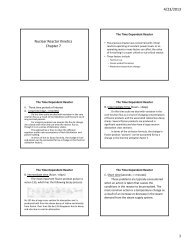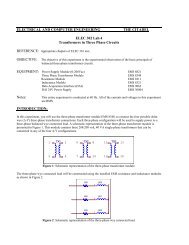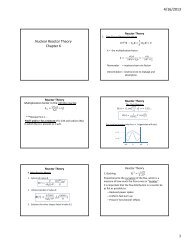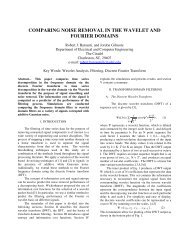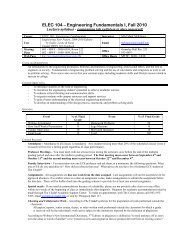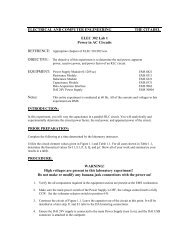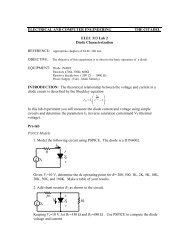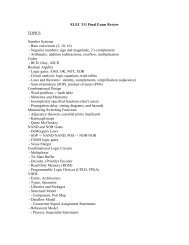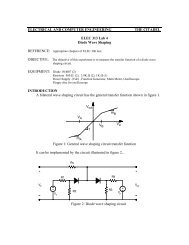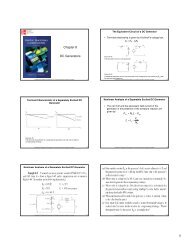1 CHAPTER 3 LEARNING OBJECTIVES Sct 3.1 Calculations for ...
1 CHAPTER 3 LEARNING OBJECTIVES Sct 3.1 Calculations for ...
1 CHAPTER 3 LEARNING OBJECTIVES Sct 3.1 Calculations for ...
You also want an ePaper? Increase the reach of your titles
YUMPU automatically turns print PDFs into web optimized ePapers that Google loves.
ENGINEERING ECONOMY, Sixth Edition<br />
M c<br />
Graw<br />
Hill<br />
Slide Sets to accompany Blank & Tarquin, Engineering<br />
Economy, 6 th Edition, 2005<br />
Slide Sets to accompany Blank & Tarquin, Engineering<br />
Economy, 6 th Edition, 2005<br />
by Blank and Tarquin<br />
<strong>CHAPTER</strong> 3<br />
COMBINING FACTORS<br />
3-1<br />
3-3<br />
© 2005 by McGraw-Hill, New York, N.Y All Rights Reserved<br />
<strong>Sct</strong> <strong>3.1</strong> <strong>Calculations</strong> <strong>for</strong> Uni<strong>for</strong>m<br />
Series that are Shifted<br />
For a shifted series the present worth point<br />
in time is NOT t = 0.<br />
It is shifted either to the left of “0” or to the<br />
right of “0”.<br />
Remember, when dealing with a uni<strong>for</strong>m<br />
series:<br />
The PW point is always one period to the left of the<br />
first series value, no matter where the series falls<br />
on the time line.<br />
© 2005 by McGraw-Hill, New York, N.Y All Rights Reserved<br />
Example of Shifted Series P and F<br />
0 1 2 3 4 5 6 7 8<br />
P0<br />
P 2<br />
Slide Sets to accompany Blank & Tarquin, Engineering<br />
Economy, 6 th Edition, 2005<br />
A = $-500/year<br />
• F <strong>for</strong> this series is at t = 6; F 6 = A(F/A,i%,4)<br />
• P 0 <strong>for</strong> this series at t = 0 is<br />
P 0 = -500(P/A,i%,4)(P/F,i%,2)<br />
3-5<br />
F 6<br />
© 2005 by McGraw-Hill, New York, N.Y All Rights Reserved<br />
<strong>LEARNING</strong> <strong>OBJECTIVES</strong><br />
Slide Sets to accompany Blank & Tarquin, Engineering<br />
Economy, 6 th Edition, 2005<br />
Consider:<br />
Slide Sets to accompany Blank & Tarquin, Engineering<br />
Economy, 6 th Edition, 2005<br />
1. Dealing with<br />
shifted series<br />
2. Shifted series<br />
and single<br />
amounts<br />
3. Shifted<br />
gradients<br />
4. Decreasing<br />
gradients<br />
5. Spreadsheet<br />
applications<br />
3-2<br />
Shifted Uni<strong>for</strong>m Series<br />
3-4<br />
© 2005 by McGraw-Hill, New York, N.Y All Rights Reserved<br />
0 1 2 3 4 5 6 7 8<br />
P 0<br />
P 2<br />
A = $-500/year<br />
P of this series is at t = 2 (P 2 ) or F 2<br />
P 2 = -500(P/A,i%,4) or could refer to as F 2<br />
P 0 = P 2 (P/F,i%,2) or could be F 2 (P/F,i%,2)<br />
Slide Sets to accompany Blank & Tarquin, Engineering<br />
Economy, 6 th Edition, 2005<br />
3-6<br />
© 2005 by McGraw-Hill, New York, N.Y All Rights Reserved<br />
<strong>Sct</strong> 3.2 <strong>Calculations</strong> Involving<br />
Uni<strong>for</strong>m-Series Uni<strong>for</strong>m Series and Randomly-Placed<br />
Randomly Placed<br />
Single Amounts<br />
Draw and correctly label the cash flow diagram that<br />
defines the problem<br />
Locate the present and future worth points <strong>for</strong> each<br />
series<br />
Write the time value of money equivalence<br />
relationships<br />
Substitute the correct factor values and solve<br />
© 2005 by McGraw-Hill, New York, N.Y All Rights Reserved<br />
1
Slide Sets to accompany Blank & Tarquin, Engineering<br />
Economy, 6 th Edition, 2005<br />
Series with additional<br />
single cash flows<br />
It is common to find cash flows that are combinations of<br />
series and single, randomly-placed cash flows<br />
For present worth, P<br />
Solve <strong>for</strong> the series present worth values then move to t = 0<br />
Then solve <strong>for</strong> the P at t = 0 <strong>for</strong> the single cash flows using the<br />
P/F factor <strong>for</strong> each cash flow<br />
Add the equivalent P values at t = 0<br />
For future worth, F<br />
Convert all cash flows to an equivalent F using the F/A and F/P<br />
factors in year t = n<br />
Add the equivalent F values at t = n<br />
3-7<br />
3.2 The PW Points are:<br />
Slide Sets to accompany Blank & Tarquin, Engineering<br />
Economy, 6 th Edition, 2005<br />
A = $500<br />
1 2 3<br />
F 4 = $300<br />
© 2005 by McGraw-Hill, New York, N.Y All Rights Reserved<br />
0 1 2 3 4 5 6 7 8<br />
i = 10%<br />
F 5 = -$400<br />
t = 1 is the PW point <strong>for</strong> the $500 annuity;<br />
“n” = 3<br />
3-9<br />
© 2005 by McGraw-Hill, New York, N.Y All Rights Reserved<br />
3.2 Write the Equivalence<br />
Statement<br />
P = $500(P/A,10%,3)(P/F,10%,2)<br />
+<br />
$300(P/F,10%,4)<br />
-<br />
400(P/F,10%,5)<br />
Substituting the factor values into the<br />
equivalence expression and solving….<br />
Slide Sets to accompany Blank & Tarquin, Engineering<br />
Economy, 6 th Edition, 2005<br />
3-11<br />
© 2005 by McGraw-Hill, New York, N.Y All Rights Reserved<br />
3.2 Series with Other cash flows<br />
♦ Consider:<br />
0 1 2 3 4 5 6 7 8<br />
Slide Sets to accompany Blank & Tarquin, Engineering<br />
Economy, 6 th Edition, 2005<br />
A = $500<br />
i = 10%<br />
F 4 = $300<br />
F 5 = -$400<br />
•Find the PW at t = 0 <strong>for</strong> this cash flow<br />
Slide Sets to accompany Blank & Tarquin, Engineering<br />
Economy, 6 th Edition, 2005<br />
3-8<br />
3-10<br />
© 2005 by McGraw-Hill, New York, N.Y All Rights Reserved<br />
3.2 The PW Points are:<br />
Back 4 periods<br />
A = $500<br />
1 2 3<br />
F 4 = $300<br />
0 1 2 3 4 5 6 7 8<br />
i = 10%<br />
Back 5 Periods<br />
Slide Sets to accompany Blank & Tarquin, Engineering<br />
Economy, 6 th Edition, 2005<br />
F 5 = -$400<br />
t = 1 is the PW point <strong>for</strong> the two other<br />
single cash flows<br />
3-12<br />
© 2005 by McGraw-Hill, New York, N.Y All Rights Reserved<br />
3.2 Substitute the factors and<br />
solve<br />
P = $500( 2.4869 )( 0.8264 )<br />
+<br />
$300( 0.6830 )<br />
-<br />
400( 0.6209 )<br />
=<br />
$984.12<br />
$1,027.58<br />
$204.90<br />
$248.36<br />
© 2005 by McGraw-Hill, New York, N.Y All Rights Reserved<br />
2
<strong>Sct</strong> 3.3 Calculation <strong>for</strong> Shifted<br />
Gradients<br />
The Present Worth of an arithmetic gradient<br />
(linear gradient) is always located:<br />
One period to the left of the first cash flow<br />
in the series ( “0” gradient cash flow) or,<br />
Two periods to the left of the “1G” cash<br />
flow<br />
Slide Sets to accompany Blank & Tarquin, Engineering<br />
Economy, 6 th Edition, 2005<br />
3-13<br />
© 2005 by McGraw-Hill, New York, N.Y All Rights Reserved<br />
Example of a Conventional Gradient<br />
♦ Consider:<br />
Slide Sets to accompany Blank & Tarquin, Engineering<br />
Economy, 6 th Edition, 2005<br />
Gradient Series<br />
……..Base Series ……..<br />
0 1 2 … n-1 n<br />
This represents a conventional gradient<br />
The present worth point is t = 0<br />
3-15<br />
© 2005 by McGraw-Hill, New York, N.Y All Rights Reserved<br />
Shifted Gradient: Numerical Example<br />
0<br />
Slide Sets to accompany Blank & Tarquin, Engineering<br />
Economy, 6 th Edition, 2005<br />
3-17<br />
G = $+100<br />
Base Series = $500<br />
1 2 3 4 ……….. ……….. 9 10<br />
Cash flows start at t = 3<br />
$500/year increasing by $100/year through<br />
year 10; i = 10%; Find P at t = 0<br />
© 2005 by McGraw-Hill, New York, N.Y All Rights Reserved<br />
A Shifted Gradient<br />
has its present value<br />
point removed from<br />
time t = 0<br />
A Conventional<br />
Gradient has its<br />
present worth point at<br />
t = 0<br />
Slide Sets to accompany Blank & Tarquin, Engineering<br />
Economy, 6 th Edition, 2005<br />
Slide Sets to accompany Blank & Tarquin, Engineering<br />
Economy, 6 th Edition, 2005<br />
Shifted Gradient<br />
3-14<br />
3-16<br />
© 2005 by McGraw-Hill, New York, N.Y All Rights Reserved<br />
Example of a Shifted Gradient<br />
Gradient Series<br />
……..Base Series ……..<br />
0 1 2 … n-1 n<br />
The present worth point <strong>for</strong> the<br />
base series and the gradient is<br />
here!<br />
This represents a shifted gradient<br />
© 2005 by McGraw-Hill, New York, N.Y All Rights Reserved<br />
Shifted Gradient: Numerical Example<br />
PW of the base series<br />
P 0<br />
0<br />
P 2<br />
Slide Sets to accompany Blank & Tarquin, Engineering<br />
Economy, 6 th Edition, 2005<br />
n series = 8 time periods<br />
Base Series = $500<br />
1 2 3 4 ……….. ……….. 9 10<br />
P 2 = 500(P/A,10%,8) = 500(5.3349) = $2667.45<br />
P 0 = 2667.45(P/F,10%,2) = 2667.45(0.8264)<br />
= $2204.38<br />
3-18<br />
© 2005 by McGraw-Hill, New York, N.Y All Rights Reserved<br />
3
Shifted Gradient: Numerical Example<br />
P 0<br />
0<br />
P 2<br />
Slide Sets to accompany Blank & Tarquin, Engineering<br />
Economy, 6 th Edition, 2005<br />
PW <strong>for</strong> the gradient component<br />
1 2 3 4 ……….. ……….. 9 10<br />
3-19<br />
G = +$100<br />
P 2 = $100(P/G,10%,8) = $100(16.0287) = $1,602.87<br />
P 0 = $1,602.87(P/F,10%,2) = $1,602.87(0.8264)<br />
= $1,324.61<br />
© 2005 by McGraw-Hill, New York, N.Y All Rights Reserved<br />
To Find A <strong>for</strong> a Shifted Gradient<br />
1) Find the present worth of the gradient<br />
at actual time 0<br />
2) Then apply the (A/P,i,n) factor to<br />
convert the present worth to an<br />
equivalent annuity (series)<br />
Slide Sets to accompany Blank & Tarquin, Engineering<br />
Economy, 6 th Edition, 2005<br />
3-21<br />
© 2005 by McGraw-Hill, New York, N.Y All Rights Reserved<br />
Shifted Geometric Gradient<br />
Slide Sets to accompany Blank & Tarquin, Engineering<br />
Economy, 6 th Edition, 2005<br />
Shifted Geometric Gradient<br />
A 1<br />
0 1 2 3 … … … n<br />
Present worth point is at t = 2 <strong>for</strong> this example<br />
3-23<br />
© 2005 by McGraw-Hill, New York, N.Y All Rights Reserved<br />
Example: Total Present Worth Value<br />
For the base series<br />
P 0 = $2204.38<br />
For the arithmetic gradient<br />
P 0 = $1,324.61<br />
Total present worth<br />
P = $2204.38 + $1,324.61 = $3528.99<br />
Slide Sets to accompany Blank & Tarquin, Engineering<br />
Economy, 6 th Edition, 2005<br />
Slide Sets to accompany Blank & Tarquin, Engineering<br />
Economy, 6 th Edition, 2005<br />
3-20<br />
3-22<br />
© 2005 by McGraw-Hill, New York, N.Y All Rights Reserved<br />
Shifted Geometric Gradient<br />
A 1<br />
Conventional Geometric Gradient<br />
0 1 2 3 … … … n<br />
Present worth point is at t = 0 <strong>for</strong> a conventional<br />
geometric gradient<br />
© 2005 by McGraw-Hill, New York, N.Y All Rights Reserved<br />
Shifted Geometric Gradient Example<br />
0 1 2 3 4 5 6 7 8<br />
A = $700/year<br />
A 1 = $400 in year t = 5<br />
Slide Sets to accompany Blank & Tarquin, Engineering<br />
Economy, 6 th Edition, 2005<br />
i = 10%/year<br />
3-24<br />
12% increase/year<br />
© 2005 by McGraw-Hill, New York, N.Y All Rights Reserved<br />
4
Geometric Gradient Example<br />
0 1 2 3 4 5 6 7 8<br />
A = $700/year<br />
PW point <strong>for</strong> the A<br />
series is t = 0<br />
PW point <strong>for</strong> the<br />
gradient is t = 4<br />
Slide Sets to accompany Blank & Tarquin, Engineering<br />
Economy, 6 th Edition, 2005<br />
i = 10%/year<br />
3-25<br />
12% increase/year<br />
© 2005 by McGraw-Hill, New York, N.Y All Rights Reserved<br />
3.3 The Annuity Present Worth<br />
♦ PW of the Annuity<br />
0 1 2 3 4 5 6 7 8<br />
A = $700/yr<br />
P 0 = $700(P/A,10%,4)<br />
Slide Sets to accompany Blank & Tarquin, Engineering<br />
Economy, 6 th Edition, 2005<br />
i = 10%/year<br />
= $700( <strong>3.1</strong>699 ) = $2,218.94<br />
3-27<br />
© 2005 by McGraw-Hill, New York, N.Y All Rights Reserved<br />
<strong>Sct</strong> 3.4 Shifted Decreasing Arithmetic<br />
Gradients<br />
Given the following shifted, decreasing gradient<br />
i = 10%/year<br />
Slide Sets to accompany Blank & Tarquin, Engineering<br />
Economy, 6 th Edition, 2005<br />
F 3 = $1,000; G = $-100<br />
0 1 2 3 4 5 6 7 8<br />
Find the present worth at t = 0<br />
3-29<br />
© 2005 by McGraw-Hill, New York, N.Y All Rights Reserved<br />
3.3 The Gradient Amounts<br />
Slide Sets to accompany Blank & Tarquin, Engineering<br />
Economy, 6 th Edition, 2005<br />
t Base Amt<br />
51<br />
$400.00<br />
62<br />
$448.00<br />
73<br />
$501.76<br />
8<br />
4 $561.97<br />
Present Worth of the Gradient at t = 4<br />
3.73674<br />
P4 = $400{ P/A1 ,12%,10%,4 } = $ 1,494.70<br />
P 0 = $1,494.70( P/F,10%,4) = $1,494.70( 0. 6830 )<br />
P 0 = $1,020,88<br />
Slide Sets to accompany Blank & Tarquin, Engineering<br />
Economy, 6 th Edition, 2005<br />
3-26<br />
3-28<br />
© 2005 by McGraw-Hill, New York, N.Y All Rights Reserved<br />
3.3 Total Present Worth<br />
♦ Geometric Gradient @ t =<br />
♦ P 0 = $1,020,88<br />
♦ Annuity<br />
♦ P 0 = $2,218.94<br />
♦ Total Present Worth”<br />
♦ $1,020.88 + $2,218.94<br />
♦ = $3,239.82<br />
© 2005 by McGraw-Hill, New York, N.Y All Rights Reserved<br />
PW <strong>for</strong> Shifted Decreasing Gradient<br />
Slide Sets to accompany Blank & Tarquin, Engineering<br />
Economy, 6 th Edition, 2005<br />
First, find PW at t = 2<br />
F 3 = $1,000; G = -$100<br />
0 1 2 3 4 5 6 7 8<br />
PW point at t = 2<br />
3-30<br />
i = 10%/year<br />
© 2005 by McGraw-Hill, New York, N.Y All Rights Reserved<br />
5
Shifted Decreasing Gradient Example<br />
i = 10%/year<br />
0 1 2 3 4 5 6 7 8<br />
P 0 here<br />
P 2<br />
Slide Sets to accompany Blank & Tarquin, Engineering<br />
Economy, 6 th Edition, 2005<br />
Second, find the PW at t = 0<br />
F 3 = $1,000; G = $-100<br />
The gradient amount is subtracted from the base<br />
amount<br />
3-31<br />
© 2005 by McGraw-Hill, New York, N.Y All Rights Reserved<br />
3.4 Time Periods Involved<br />
0 1 2 3 4 5 6 7 8<br />
P 0 here<br />
Slide Sets to accompany Blank & Tarquin, Engineering<br />
Economy, 6 th Edition, 2005<br />
Slide Sets to accompany Blank & Tarquin, Engineering<br />
Economy, 6th Edition, 2005<br />
F 3 = $1,000; G=-$100<br />
1 2 3 4 5<br />
P 2 or, F 2 : Take back to t = 0<br />
Dealing with n = 5.<br />
3-33<br />
Summary<br />
i = 10%/year<br />
© 2005 by McGraw-Hill, New York, N.Y All Rights Reserved<br />
Chapter summarizes cash flow<br />
patterns that are shifted away from time<br />
t = 0<br />
Illustrations of using multiple factors<br />
to per<strong>for</strong>m PW or FW analysis <strong>for</strong><br />
shifted cash flows<br />
Illustrations of shifted arithmetic and<br />
geometric gradients<br />
Illustrations of the power of Excel<br />
© 2005 by McGraw-Hill, New York, N.Y All Rights Reserved<br />
financial functions3-35<br />
Shifted Decreasing Gradient Example<br />
i = 10%/year<br />
0 1 2 3 4 5 6 7 8<br />
P 0 here<br />
P 2<br />
Slide Sets to accompany Blank & Tarquin, Engineering<br />
Economy, 6 th Edition, 2005<br />
Slide Sets to accompany Blank & Tarquin, Engineering<br />
Economy, 6 th Edition, 2005<br />
F 3 = $1,000; G = -$100<br />
Base amount = $1,000<br />
3-32<br />
3-34<br />
© 2005 by McGraw-Hill, New York, N.Y All Rights Reserved<br />
3.4 Time Periods Involved<br />
F 3 = $1,000; G=-$100<br />
$1,000<br />
G = -$100/yr<br />
1 2 3 4 5<br />
i = 10%/year<br />
0 1 2 3 4 5 6 7 8<br />
P 2 = $1,000( P/A,10%,5 ) – 100( P/G,10%.5 )<br />
P 2 = $1,000( 3.7908 ) - $100( 6.8618 ) = $3,104.62<br />
P 0 = $3,104.62( P/F,10%,2 ) = $3104.62( 0 .8264 ) = $2,565.65<br />
Slide Sets to accompany Blank & Tarquin, Engineering<br />
Economy, 6 th Edition, 2005<br />
<strong>CHAPTER</strong> 3<br />
<strong>CHAPTER</strong> 3<br />
End of Slide Set<br />
3-36<br />
© 2005 by McGraw-Hill, New York, N.Y All Rights Reserved<br />
© 2005 by McGraw-Hill, New York, N.Y All Rights Reserved<br />
6



